AMD Radeon HD 7870 GHz Edition & Radeon HD 7850 Review: Rounding Out Southern Islands
by Ryan Smith on March 5, 2012 12:01 AM ESTOverclocking: Power, Temp, & Noise
As with the rest of Southern Islands, AMD is making sure to promote the overclockability of their cards. And why not? So far we’ve seen every 7700 and 7900 card overclock by at least 12% on stock voltage, indicating there’s a surprising amount of headroom in these cards. The fact that performance has been scaling so well with overclocking only makes overclocking even more enticing. Who doesn’t want free performance?
So how does Pircairn and the 7800 series stack up compared to the 7700 and 7900 series when it comes to overclocking? Quite well actually; it easily lives up to the standards set by AMD’s previous Southern Islands cards.
| Radeon HD 7800 Series Overclocking | ||||
| AMD Radeon HD 7870 | AMD Radeon HD 7850 | |||
| Shipping Core Clock | 1000MHz | 860MHz | ||
| Shipping Memory Clock | 4.8GHz | 4.8GHz | ||
| Shipping Voltage | 1.219v | 1.213v | ||
| Overclock Core Clock | 1150MHz | 1050MHz | ||
| Overclock Memory Clock | 5.4GHz | 5.4GHz | ||
| Overclock Voltage | 1.219v | 1.213v | ||
Overall we were able to push our 7870 from 1000MHz to 1150MHz, representing a sizable 15% core overclock. This is now the 3rd SI card we’ve hit 1125MHz or 1150MHz – the other two being the 7970 and the 7770 – so AMD’s overclocking headroom has been extremely consistent for their upper tier cards.
As for memory overclocking, we hit 5.4GHz on both cards before general performance started to plateau, representing a 12.5% memory overclock. Considering that both cards use the same RAM on the same PCB, and the performance limitation is the memory bus itself, this is consistent with what we would have expected. With that said, we are a bit surprised that we got so far over 5GHz on 2Gb GDDR5 memory chips only rated for 5GHz in the first place; it indicates that Hynix’s GDDR5 production very mature.
With that said, because of the unique and non-retail nature of the 7850 AMD supplied us, the 7850 overclocking results should be considered low-confidence. The retail 7850 cards will be using simpler and no doubt cheaper coolers, PCBs, and VRMs; all of these can reduce the amount of overclocking headroom a card has. It’s by no means impossible that a 7850 could hit 1050MHz/5.4GHz, but it’s far more likely on a 7870 PCB than it is on a 7850 PCB.
Anyhow we’ll take a look at gaming performance in a moment, but in the meantime let’s take a look at what our overclocks do to power, temperature, and noise.
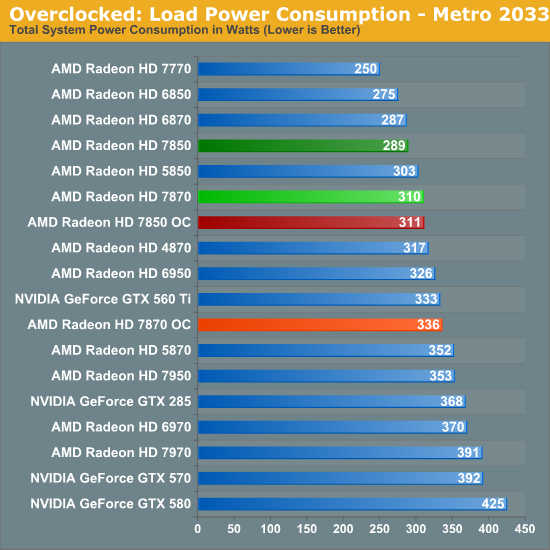
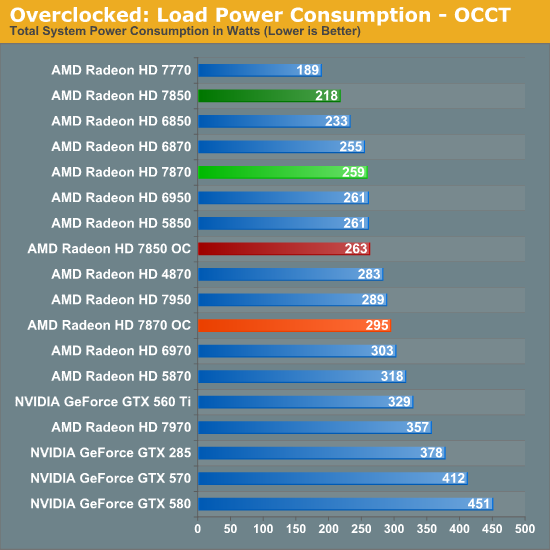
Even without a voltage increase overclocking does cause power consumption to go up, but not by a great deal. Under Metro the total difference is roughly 21W for the 7850 and 25W for the 7870, at least some of which can be traced back to the increased load on the CPU. Whereas on OCCT there’s a difference of nearly 40W on both cards, thanks to the increased PowerTune limits we’re using to avoid any kind of throttling when overclocked. All things considered with our overclocks power consumption for the 7850 approaches that of the 7870 and the 7870 approaches the GTX 560 Ti, which as we’ll see is a fairly small power consumption increase for the performance increase we’re getting.
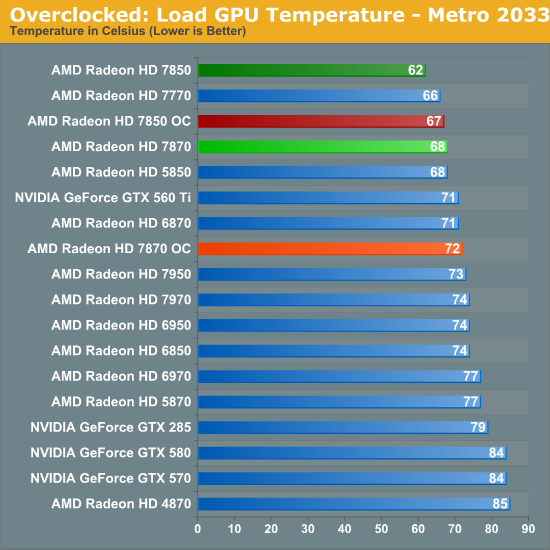
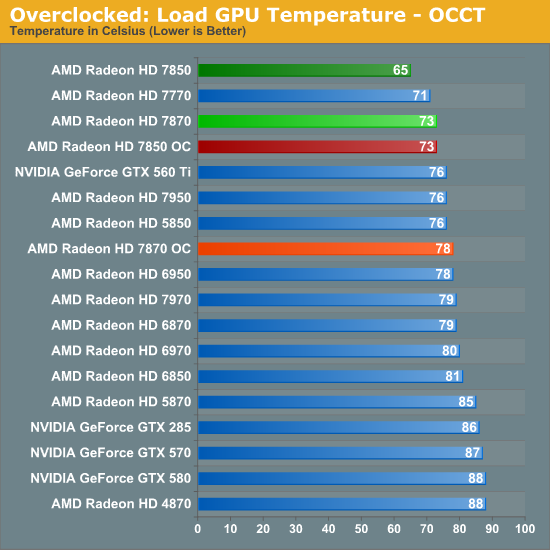
Of course when power consumption goes up so does temperature. For both cards under Metro and for the 7870 under OCCT this amounts to a 5C increase, while the 7850 rises 8C under Metro. However as with our regular temperature readings we would not suggest putting too much consideration into the 7950 numbers since it’s using a non-retail design.
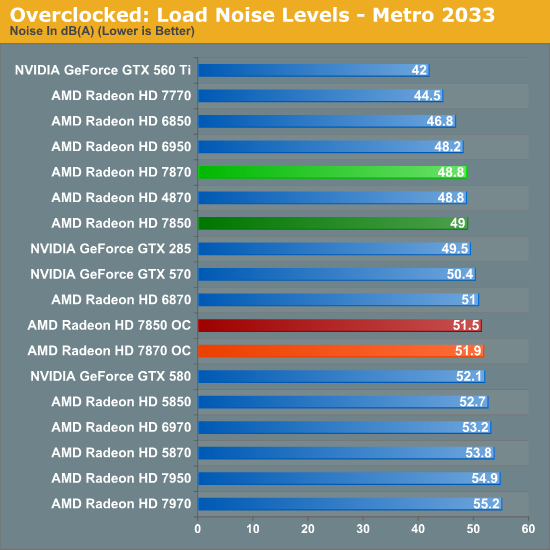
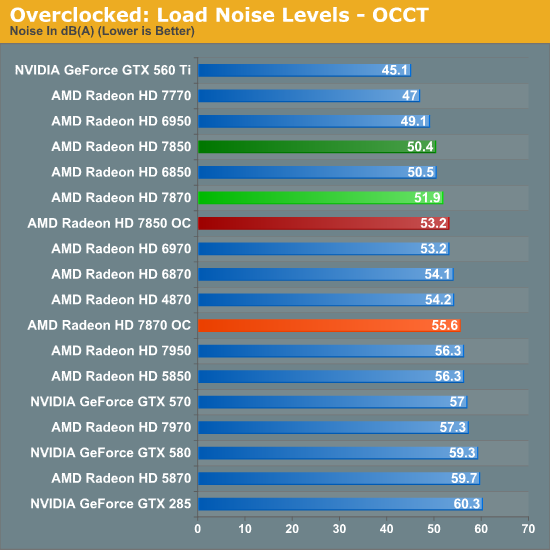
AMD’s conservative fan profiles mean that what are already somewhat loud cards get a bit louder, but in spite of what the earlier power draw differences would imply the increase in noise is rather limited. Paying particular attention to Metro 2033 here, the 7870 is just shy of 3dB louder at 51.9dB, while the 7850 increases by 2.7dB to 51.5dB. OCCT does end up being worse at 2.8dB and 3.7dB louder respectively, but keep in mind this is our pathological case with a much higher PowerTune limit.










173 Comments
View All Comments
chizow - Monday, March 5, 2012 - link
Sorry, fact checking 101 says the 7850 is still clearly behind the 570, about 10% faster than the GTX 560Ti ($200). The 7870 may be the SKU you're referring to but it costs $350, which again, brings very little movement on pricing:performance relative to 14-16 month old parts.CeriseCogburn - Thursday, March 8, 2012 - link
Hey don't be so factual. medi01 can also look forward to blurred up MLAA, lack of LOD detail compensation, no PhysX, drivers crashing like mad inexplicably for a year or two until things get "ironed out", new games "not running", mouse cursors stuck in corners, whining about tessellation levels in games "it can't handle", and generally blaming nvidia for all it's failures...The "$80" imaginary dollars he saves he can "reinvest" in a "solid" with a "for sure" payoff - his endless hours "fixing" his 7850 "issues".
SlyNine - Monday, March 5, 2012 - link
That's a very 1 dimensional opinion. Compared to the 5870 node change which equaled 2x performance for around the same price, A fab shrink that doesn't double your performance for the money is disappointing.We are comparing it to how past node changes changed the price/performance model. This one is HORRIBLE because it basically slides right in to the old one, so now we have a node change that does very little for price.
I'm running a 5870 which is basically 75% the performance of a 7970, and I paid 379 for the 5870. Which is also 75% of the cost of a 7970. The price of a 7970 is basically the exact same price structure as the 2 1/2 year old 5870, So we are stuck where we were in 2009, yay.
morfinx - Monday, March 5, 2012 - link
75% performance of 7970 would mean that it's 33% faster than a 5870. And that's just not accurate. I have a 5870 as well, so I was paying a lot of attention on how much faster the 7970 is in various reviews. Everything I've read indicates that it's anywhere from 70-110% faster at 2560x1600 resolution (I run 3600x1920, so likely even even more of a difference). That's not even even considering the massive overclocking headroom of the 7970 vs barely any OC headroom of the 5870. Overclocked, a 7970 is easily twice as fast as a 5870.SlyNine - Thursday, March 8, 2012 - link
I should have said 66% for 66% of the price. Point being the price/Performance has not improved...Its around 40-60% faster according to Anandtech's benchmarks.
Overclocked, don't make me laugh.
chizow - Monday, March 5, 2012 - link
@Kiste: Agreed, don't worry about the criticism you're taking. This site has a lot of readers with very low standards or very limited perspective when it comes to the GPU industry.7000 series pricing and performance is a disappointment so far, there's no doubt about it. You can throw as much historical perspective and factual pricing/performance at them but you''ll just be greeted with blank stares and accusations of fanboyism.
Bottomline is this, if Nvidia follows this price and performance structure, EVERYONE would be disappointed.
If Nvidia took 14-16 months and only improved their entire product stack 15-25% on a new architecture and new process node with Kepler while increasing prices accordingly, it'd be a colossal failure.
It makes you wonder why the AMD fans don't see it the same way?
Kaboose - Monday, March 5, 2012 - link
you're acting like Kepler has been released and Nvidia won't be doing the same exact thing, I really doubt we will see Nvidia releasing higher performing cards then AMD at much lower prices like you see to think.chizow - Monday, March 5, 2012 - link
I didn't say we know what Kepler holds, what I'm saying is *IF* Nvidia did this, it would be a colossal failure and we could just write off 28nm entirely. That's why it makes you wonder why AMD fans are giving them a pass for such little improvement in performance and pricing.Honestly, with 15-25% improvement top to bottom over existing SKUs, Nvidia could have simply refreshed their entire Fermi line-up and hit those targets with just clockspeed increases from the smaller process.
At no other point in the history of GPUs has a new process/architecture from either IHV brought so little movement in price and performance. There's no innovation here and no incentive for anyone who bought in the last few generations to bother upgrading.
If you have a 5850/470 or better, there is VERY little reason to upgrade right now especially at the asking prices.
Kaboose - Monday, March 5, 2012 - link
What % of people have 5850/470 or better GPUs though? Im going to say not many. 7850/7870 are good cards for people entering the market on mid range desktops that want to add a GPU for gaming. As well as HTPC use. And for system builders who are looking for a good OC and current gen. technology.Ananke - Monday, March 5, 2012 - link
See Steam statistics. The 5th series was the majority. The largest target market are owners of 5850/5870. I have 5850 and I can afford any card, but I see no reason to upgrade. At this price point gaming is not the only usage, I want quality hardware video encoding acceleration by MANY software packages, GPGPU applications. Today, in those areas, AMD has actually even less applications than when they launched the 5th series.For SO much money and NO applications outside gaming the ONLY reason not to use NVidia would be heat dissipation. If Kepler cards are colder, NVidia has a win.